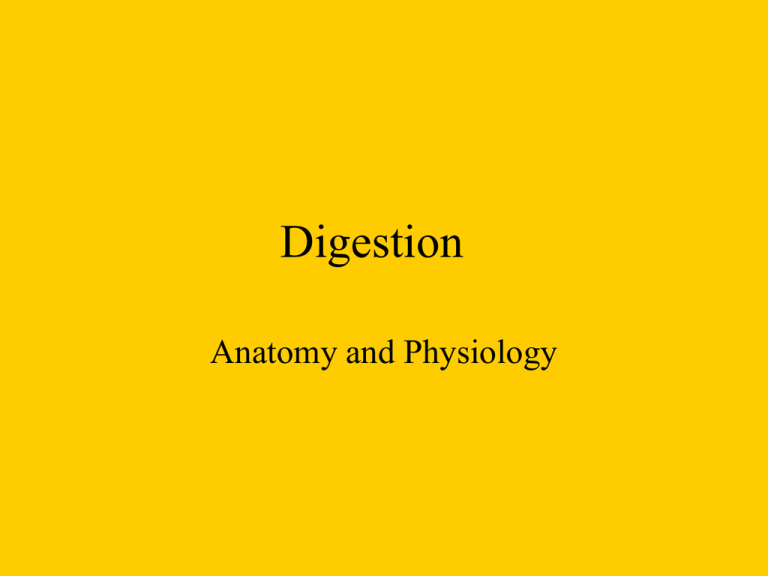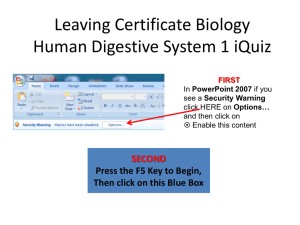Digestion
advertisement

Digestion Anatomy and Physiology Why must we digest our food? • To break down foods into small, useable nutrients • A chunk of hamburger is not useable to a cell • The process is both mechanical and chemical Major and Minor Players • Alimentary canal extends from mouth to anus (9 meters long) • Includes every part the food material actually passes through • Accessory organs supply enzymes to help, but food does not actually pass through • Alimentary canal: mouth, esophagus, stomach, small intestine, large intestine, anal canal • Accessory organs: salivary glands, liver, gallbladder, pancreas. Peristalsis • A wave- like motion that moves food through the alimentary canal • Smooth muscle action Mouth Mouth • Mechanical digestion begins here with chewing • 32 secondary teeth • Structure is suited to function • Outer covering is enamel, under it is dentin Mouth • Three pairs of salivary glands secrete saliva • Parotid, sublingual, and submandibular • Saliva dissolves foods, moistens for easier swallowing, and begins chemical digestion Mouth • An enzyme called amylase is found in saliva • This enzyme splits starch into disaccharides Swallowing • The pharynx is the area behind the mouth leading to the esophagus • Esophagus leads to the stomach • Soft palate raises so food will not go into nasal cavity • Epiglottis closes off the trachea • Peristalsis forces food into and on through the esophagus • Esophagus penetrates the diaphragm • Entrance is guarded by a sphincter, which opens to let food in, and closes to prevent regurgitation Swallowing Stomach • J shaped organ • Holds about 1 liter • Churns food and mixes it with gastric juices • Begins protein digestion • Passes food into small intestine Stomach • Gastric juices consist of mucous, digestive enzymes, and hydrochloric acid (HCl) • Lining of stomach is thick, has a coating to protect it • A hole in the lining is an ulcer Stomach • Protein digestion begins in stomach with the enzyme pepsin ( likes acid conditions) • Cells secrete pepsinogen, which is changed into pepsin when it encounters the HCl Stomach • Only protein is chemically digested in the stomach. • The pH is very acidic, and only pepsin can function Stomach • Not much absorption occurs from the stomach into the bloodstream • Absorbs only small amounts of water and salts, alcohol, some drugs Small Intestine • Two main jobs: • Most digestion occurs here; digestion is finished here • Nutrients are absorbed into the bloodstream • Neutralizes stomach acid, so enzymes can work Small Intestine • Consists of three sections: duodenum, jejunum, and ileum • Receives secretions from the liver and pancreas, as well as making its own Small Intestine • Peptidases: digest proteins • Sucrase, maltase, lactase split disaccharides into monosaccharides • Lipase splits lipids into glyrcerol and fatty acids Small Intestine • Inner wall is lined with tiny projections called villi • Increases surface area for more and better absorption of nutrients Large Intestine (colon) • Begins in the lower right side of abdomen and extends up, across, and down the left side to the anus • Sections are: ascending colon, transverse colon, descending colon, and sigmoid colon Large Intestine (colon) • No digestion takes place here • Absorbs water and electrolytes into bloodstream • Stores feces Colon Cancer • Formation of cancerous polyps • Easy screening test • High cure rate if caught early Accessory Organs • • • • Salivary glands Liver Gall bladder Pancreas Liver • Two large lobes • Reddish brown color • Important in carbohydrate metabolism (stores glucose as glycogen) • Also important in lipid and protein metabolism • Liver also stores many substances • Helps destroy damaged red blood cells and pathogens • Removes toxic substances from blood (such as alcohol) Liver • None of those functions is important to digestion. • Secretion of bile is important to digestion • Bile aids digestive enzymes by emulsifying fats Liver • Emulsification is the breaking of fat globules into smaller droplets • Lipases can then work better Gall Bladder • Stores the bile made by the liver • Attached to the underside of the liver • Releases bile into the small intestine Pancreas • Both an endocrine and a digestive organ • Secretes pancreatic juice (full of enzymes) into small intestine • Enzymes include: pancreatic amylase, pancreatic lipase, trypsin and other protein splitters Pancreas







